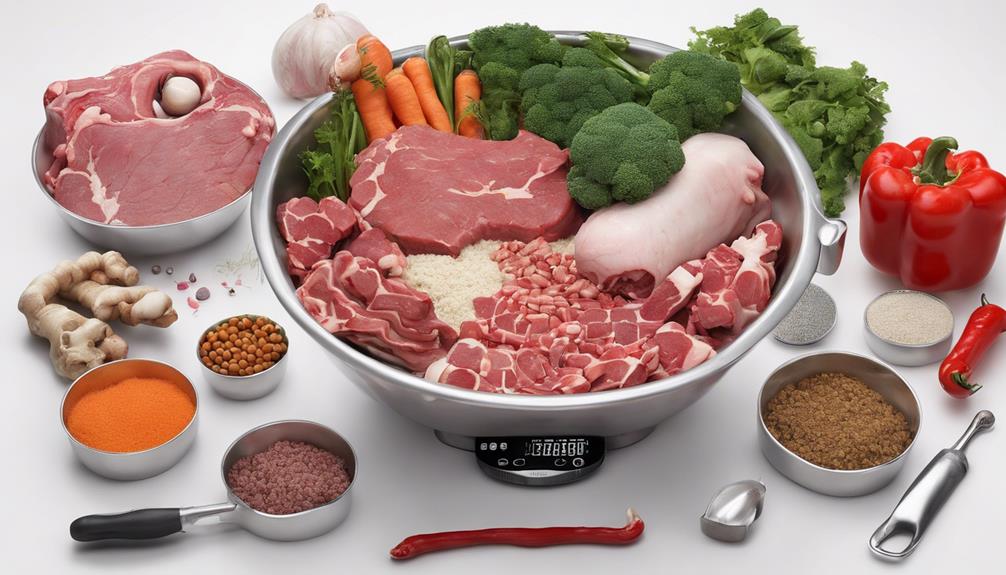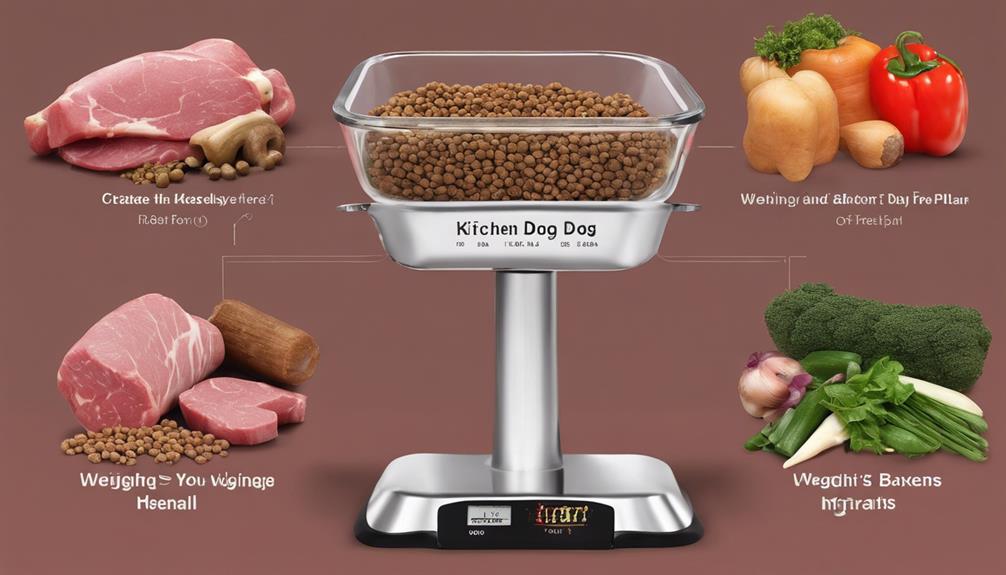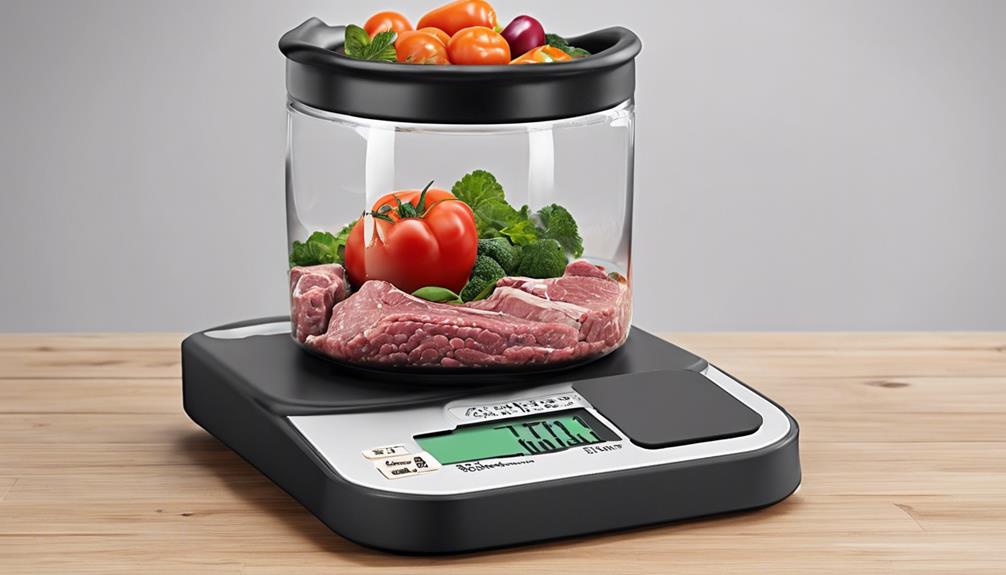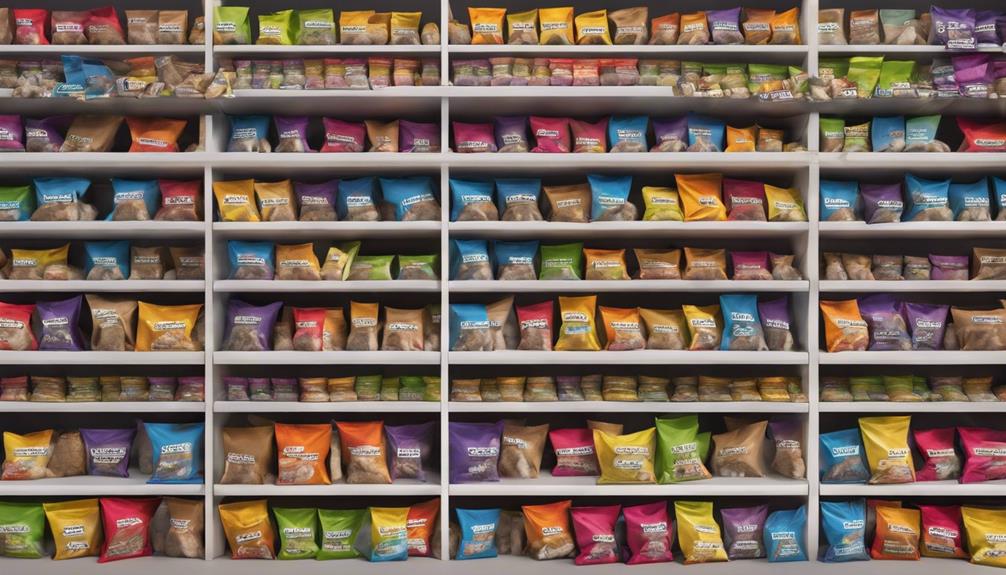Mastering weighing raw dog food is crucial to meeting your furry friend's nutritional needs precisely. Using a digital kitchen scale, I accurately portion out protein, muscle meat, organ meats, and raw meaty bones based on my dog's weight. By dividing the total food needed into individual portions and consistently recording ingredient weights, I guarantee balanced nutrition. I then balance the meal plan with correct proportions of essential protein sources, organ meats, and raw meaty bones. Regularly monitoring my dog's weight and health indicators allows me to adjust portions effectively for their well-being.
Key Takeaways
- Use a digital kitchen scale for accurate ingredient weighing.
- Portion ingredients based on the dog's weight for balanced nutrition.
- Divide total food into individual portions for each dog.
- Record ingredient weights for consistency and adjustment.
- Adjust portions based on health, activity, and weight changes.
Understanding a Dogs Nutritional Needs
Understanding a dog's nutritional needs is essential for formulating a balanced and beneficial raw diet plan. When it comes to raw pet food for dogs, protein plays a vital role. Protein is necessary for muscle growth, repair, and overall health in our canine companions. Choosing high-quality protein sources such as lean meats, fish, and organ meats is crucial to make certain your dog receives the necessary amino acids for peak health.
Incorporating a variety of protein sources in your dog's diet can help prevent deficiencies and support their overall well-being. When preparing a raw diet plan for your dog, it's important to take into account their individual requirements based on factors like age, activity level, breed, and health status. By understanding the importance of protein in your dog's diet and tailoring their food accordingly, you can provide them with a balanced and nourishing meal that supports their health and vitality.
Transitioning to Raw Dog Food

For a smooth shift to a raw diet for your dog, it's recommended to gradually introduce raw meals alongside their current food, monitoring their stool consistency and overall health throughout the process.
Start by mixing small amounts of raw dog food with their usual kibble. This gradual introduction helps prevent digestive issues that may arise from a sudden change in diet. Over the course of 1-2 weeks, slowly increase the ratio of raw food to their existing food.
Keep a close eye on your dog's stool to make sure it remains firm and well-formed, indicating a smooth shift. Additionally, observe your dog for any changes in energy levels, coat condition, or overall well-being. If you notice any concerns during this change period, consult with your veterinarian for guidance on how to best proceed with feeding raw dog food.
Weighing and Portioning Raw Ingredients
When preparing raw dog food meals, guarantee accurate weighing of ingredients using a digital kitchen scale to maintain proper nutrition for your pet.
To make sure you feed your dog a balanced diet, follow these essential steps:
- Use a Digital Kitchen Scale: Invest in a reliable digital kitchen scale to accurately measure the raw ingredients for your dog's meals.
- Keep Raw Ingredients Separate: Portion out the correct amount of protein, muscle meat, organ meats, and raw meaty bones based on your dog's weight to maintain a balanced diet.
- Portion Out Individual Meals: Divide the total food needed for both dogs into individual portions to ensure each dog receives the appropriate nutrients.
- Maintain Consistency: Keep a record of the weights of each ingredient to maintain consistency in your dog's diet and adjust portion sizes as needed based on your dogs' digestion, weight, and overall health.
Balancing a Dogs Meal Plan

To guarantee a well-rounded and nutritious diet for your dog, it's essential to carefully balance their meal plan by incorporating the correct proportions of protein, muscle meat, organ meats, and raw meaty bones. Protein sources are important for your dog's overall health and should include options such as chicken, turkey, beef, and fish in appropriate amounts. These proteins provide essential amino acids necessary for muscle development and energy.
Organ meats like liver and kidney are rich in vitamins and minerals, supporting your dog's immune system and overall well-being. Incorporating organ meats ensures your dog receives critical nutrients that may be lacking in other parts of their diet.
Additionally, raw meaty bones, such as chicken drumsticks, not only help maintain dental health but also provide minerals like calcium and phosphorus. Balancing these components in your dog's meal plan is key to meeting their nutritional requirements and promoting a healthy and happy life.
Monitoring and Adjusting for Health
Consistently monitoring your dog's weight is crucial to guarantee that their raw diet is meeting all their nutritional requirements effectively. Here are four essential steps to make sure your dog's health and well-being while on a raw diet:
- Regular Monitoring: Weigh your dog at least once a month to track any fluctuations that may indicate the need for adjustments in their raw food portions.
- Adjust Portion Sizes: Modify the amount of raw dog food based on your pet's digestion, activity level, and overall health status. Be attentive to any changes in weight or appetite.
- Consult with a Veterinarian: If you notice any concerning changes in your dog's health or weight, seek advice from a veterinarian specializing in raw feeding to address any potential issues promptly.
- Track Health Improvements: Keep a record of any positive or negative health developments after shifting to a raw diet. Use this information to fine-tune the portions and ingredients for best results.
Frequently Asked Questions
What Is the 80 10 10 Rule for Raw Dog Food?
The 80 10 10 rule for raw dog food prescribes a balanced diet with 80% muscle meat, 10% organ meats, and 10% raw meaty bones. This ratio guarantees dogs receive essential nutrients like proteins, fats, and minerals for peak health.
How Do You Calculate Raw Food for Dogs?
To calculate raw food for dogs, I determine 2%-3% of my dog's body weight, like feeding 1-1.5 pounds to a 50-pound dog daily. I adjust portions based on activity level and metabolism, using a kitchen scale for accuracy, and consulting with a vet for guidance.
What Is the 95 Rule for Dog Food?
The 95 rule for dog food emphasizes feeding canines 95% raw meat, organs, and bones to guarantee a balanced, nutrient-rich diet. The remaining 5% can include fruits, veggies, and supplements. This rule is essential for providing dogs with a natural, species-appropriate diet.
How Do You Make 80 10 10 Complete?
To make 80 10 10 complete, I liken it to crafting a nutritious symphony: blend 80% muscle meat for protein, 10% bone for calcium, 10% organ meat for essential nutrients. Following this ratio guarantees a harmonious diet for my pup.
What Are the Essential Steps for Weighing Raw Dog Food at Home?
When preparing a homemade raw dog food recipe, it’s essential to weigh the ingredients accurately. First, measure the amount of muscle meat, organs, and bones as per the recipe. Be mindful of portion size to ensure your furry friend gets the right nutrients in every meal.
Conclusion
Well, there you have it folks – the essential steps to mastering weighing raw dog food. Remember, your furry friend's health is in your hands, so don't take it lightly.
Adapting, weighing, balancing, monitoring – it may sound like a lot of work, but trust me, seeing your dog thrive on a homemade, nutritious diet is worth every ounce of effort.
So go ahead, embrace the raw feeding lifestyle and watch your pup wagging with joy!










